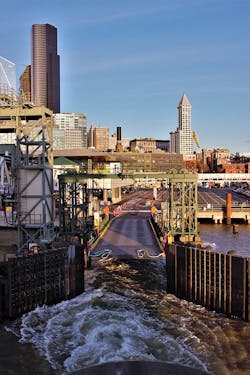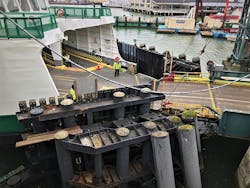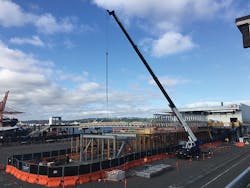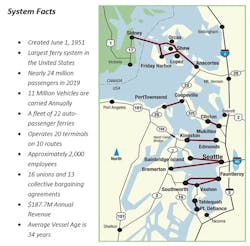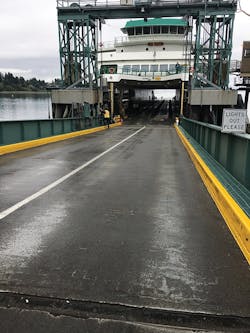Sustaining a marine highway system in Washington State
Washington State Ferries (WSF) is the largest ferry system in the U.S., serving eight counties within Washington and the Province of British Columbia in Canada.
The agency is a division of the Washington State DOT (WSDOT) and, as such, its terminals and vessels are designated as part of the state highway system. WSF’s white and green boats are as iconic as the scenic waterways which they sail and mean many things to many people: a scenic ride to work or school, a popular attraction for sightseeing visitors, a critical connection to health and well-being, or a fundamental link to economic prosperity.
WSF began operations in 1951 after the state bought the assets of the Puget Sound Navigation Company (Black Ball Line), which had been operating the ferries for decades. The ferry system operates 22 vessels that carry vehicles and passengers on 10 different routes throughout the Puget Sound, and provides the equivalent to 200 miles of highway bridges.
While WSF’s vessels are easily the most recognizable part of the system, its 20 terminals play a key role in the agency’s ability to maintain service and complete all scheduled trips. Maintenance and preservation of the WSF terminals is crucial to WSDOT’s mission to “provide safe, reliable, and cost-effective transportation options to improve communities and economic vitality for people and businesses.”
Regular maintenance and repair at WSF’s ferry terminals is challenging. Constant exposure to the Puget Sound’s corrosive saltwater accelerates the deterioration of the marine facilities. Over the years, the ferry terminals were repaired, retrofitted, or replaced at multiple times, with different construction materials and standards. Engineering design standards, construction materials, and environmental requirements are continuously changing. A terminal designed 10 years ago had different design requirements than the new terminals designed today or in the future.
Currently, two of WSF’s busiest ferry terminals are in various stages of construction: Colman Dock, the system’s flagship terminal in downtown Seattle; and the Mukilteo terminal, which serves the route with the highest vehicular traffic within the system. These vastly different projects illustrate WSF’s commitment to providing reliable service, continually improving the customer experience, and focusing on sustainability.
Seattle Multimodal Terminal at Colman Dock
In May 1966, WSF dedicated what the Seattle Times referred to as “its flossiest shoreside facility,” the new Seattle Ferry Terminal at Colman Dock. Located on the Seattle waterfront, the terminal at Colman Dock is WSF’s largest and busiest facility. It serves two major ferry routes—Bainbridge Island and Bremerton—which, combined, carry nearly 9 million passengers each year.
Now, 54 years later, Colman Dock is in the middle of a major overhaul to improve seismic safety and efficiency throughout the site. The facility remains at full operational capacity during this construction activity. Many people depend on this ferry terminal to travel for work, play, deliveries, and doctor’s appointments.
What does it take to ensure the largest terminal in the largest ferry system in the U.S. can stand up to a major seismic event? A key part of the work at Colman involves removing the old creosote-soaked timber piles (some in place since 1938) and timber trestle portions of the deck and replacing them with steel and concrete piles designed to withstand large earthquakes. This requires a great number of piles. Nearly 500 steel seismic-grade pilings to be exact, each up to 3 ft in diameter and 150 ft long. One steel pile covers the same ground as three or more old wooden piles.
Vibratory hammers drive the first 138 ft of each new hollow steel pile into Elliott Bay and then an 11-ton hammer, powered by a 1,000-hp motor large enough to run a locomotive, that sits atop a towering crane is sent barreling down on the pile repeatedly until the column is firmly embedded into the earth. In-water construction such as pile driving can only take place during a federally designated “fish window” meant to protect salmon and other marine wildlife. The fish window is from Aug. 1 to Feb. 15 each year.
Since construction began in 2017, the Colman Dock team has already completed a new passenger-only ferry facility and a new passenger overhead loading facility on the most northern slip of the terminal. The old terminal building has been completely demolished, and the first one-third of the new terminal building is constructed and commissioned. An elevated walkway between the new terminal building and the passenger-only ferry facility is in operation.
When complete, the redesigned Seattle Multimodal Terminal at Colman Dock will also include a bicycle entry and holding area and an elevated pedestrian bridge to connect with the pedestrian promenade on Alaskan Way. The city of Seattle, Seattle DOT, and WSDOT are working on a massive pedestrian and public space-oriented redesign of Alaskan Way.
Mukilteo Multimodal Terminal
WSF’s Clinton/Mukilteo route connects residents and visitors on Whidbey Island to the city of Mukilteo, 25 miles north of Seattle. In 2019 this route carried 2.3 million vehicles and 4.1 million passengers.
Unlike Colman Dock, which has to stay operational while construction is going on, WSF is building an entirely new Multimodal Ferry Terminal one-third of a mile east of the existing 63-year-old, seismically vulnerable terminal.
The site for the new terminal is historically significant as the place of the 1855 signing of the Point Elliott Treaty between the U.S. government and the Native American tribes of the greater Puget Sound region, establishing reservations and securing tribal hunting and fishing rights. WSF signed an agreement with seven Coast Salish tribes to honor the site’s spiritual and historical significance and consulted with them during design.
The tribes asked that the new terminal be light on the earth; the city of Mukilteo asked that it be green; WSDOT asked for it to be LEED certified. These three requests easily merged into a passenger terminal that is a modern interpretation of a Coast Salish longhouse, integrating solar panels, passive/natural ventilation, rainwater harvesting, radiant floor heating, and other green elements into its LEED Silver design.
The terminal also sits on what was once a U.S. Air Force fueling station. This project restores that site along the Mukilteo waterfront to a more natural environment by removing a 1,360-ft fueling pier–and 7,000 tons of toxic creosote–from the Puget Sound and building on top of the pads that used to hold 10 fuel storage tanks.
When it opens in the fall of 2020, the new Mukilteo Multimodal Terminal will increase transportation safety and reliability for this growing Seattle metropolitan region. In addition to its green passenger building, the new terminal will be fully ADA-compliant and feature an overhead passenger loading system, an important addition because the number of pedestrian passengers aboard the route is expected to increase 20% by 2040. The new terminal also includes a transit pick-up and drop-off area and is closer to a Sound Transit commuter rail station.
The project gives the Mukilteo waterfront back to the residents and provides a beautiful waterfront promenade that will be the centerpiece of the city’s Downtown Waterfront Master Plan.
Looking Ahead
Shifting demographics—including explosive growth in Washington State and the increasing popularity of ferry travel—present WSF with many challenges to overcome.
Each terminal capital investment project, whether preservation or improvement, is designed to meet the requirements in WSF’s Terminal Design Manual. These include standards that allow for more efficient and reliable operations, and the safe movement of motorized and non-motorized vehicles and pedestrians on and off the vessels, through the terminal, and ultimately connecting them with transit or other means of transportation. Other requirements include environmentally friendly means and methods of construction, with a focus on locally sourced materials when possible, and the reduction of waste and energy use at the facility.
As ferry ridership continues to grow, more and more pressure will be placed on WSF’s terminals to move customers through as efficiently as possible to maintain ferry service schedules. At the same time, emerging mobility technologies and partnership opportunities will call upon WSF to reassess terminal configurations and operations to best meet the needs of the system and its customers.
WSF’s 2040 Long Range Plan calls for partnerships with regional and local transit agencies to enhance customer mobility and provide more transportation options for WSF customers. It also calls for a large investment in the electrification of the fleet by 2040. To realize the benefits of plug-in electric-hybrid propulsion, a plan to modify 17 terminals is included.
The WSF strategy provides for a ferry system that contributes to cleaner air and healthier marine life on the Washington coasts, a more seismically sound transportation infrastructure and, most of all, a consistent, reliable transportation network that contributes to Washingtonians’ economic health and quality of life for the next 20 years and beyond.
